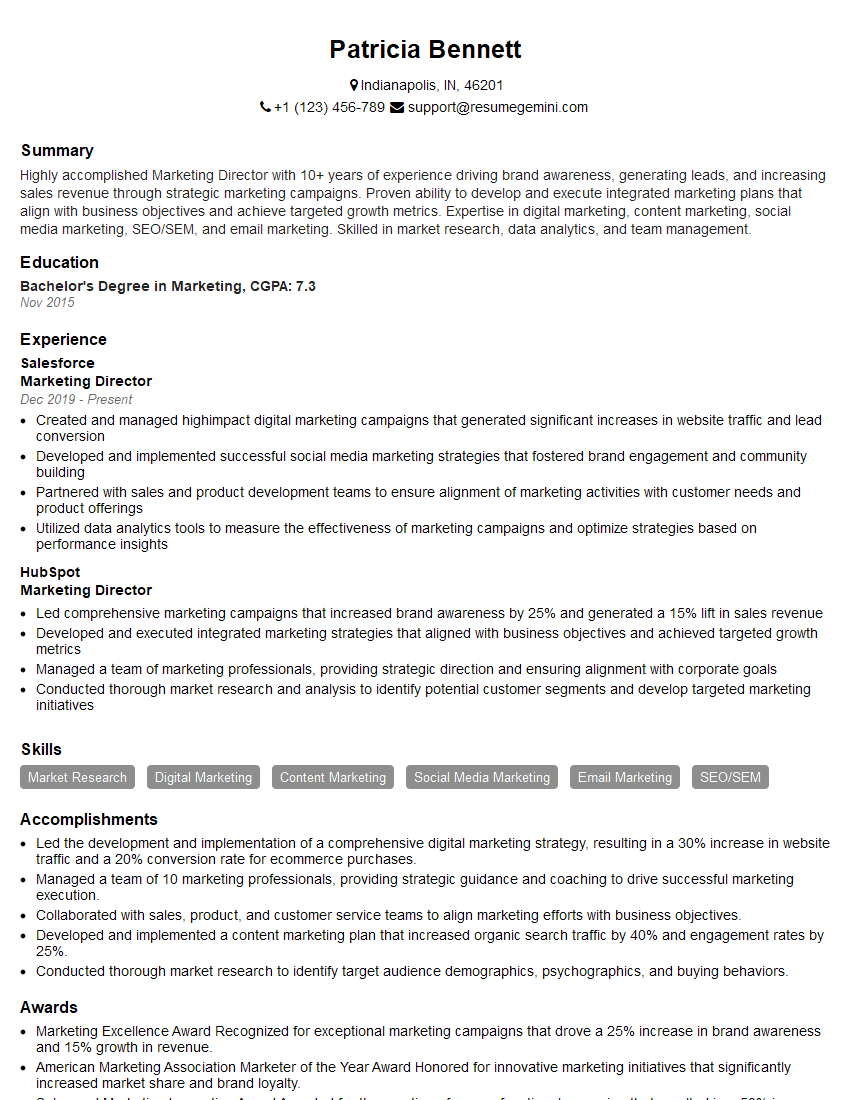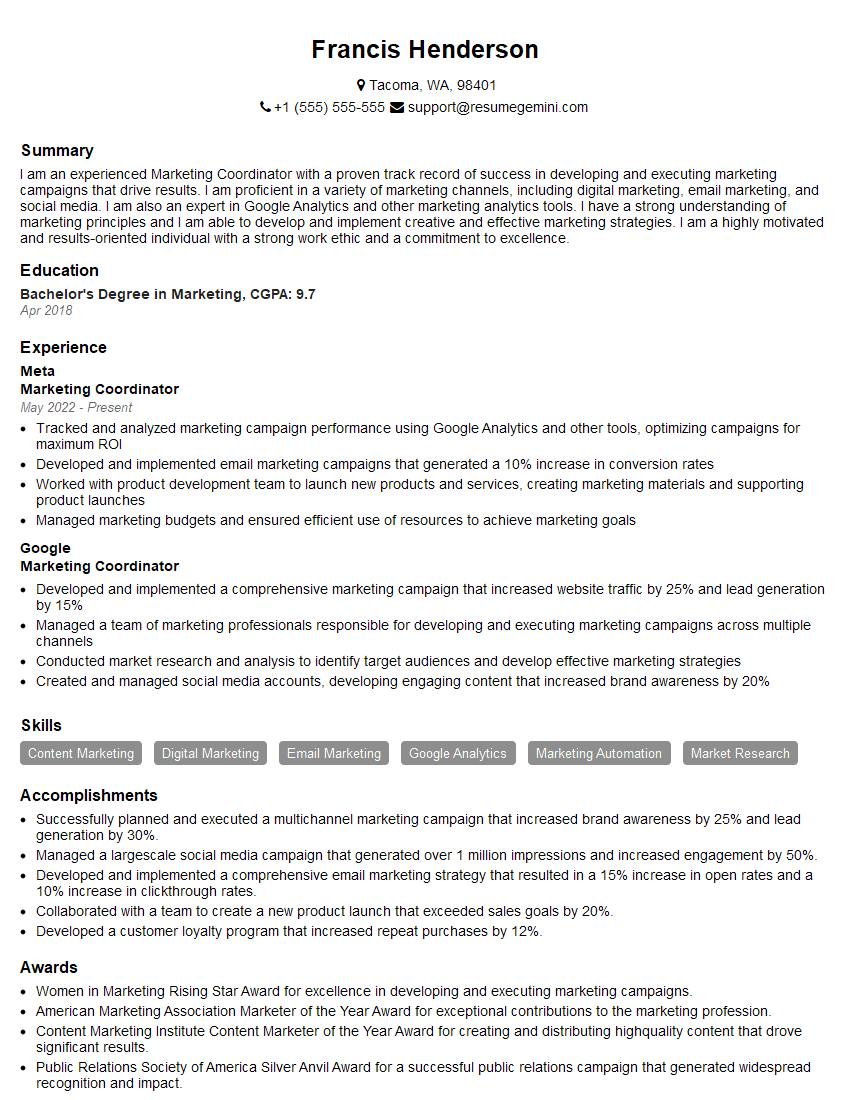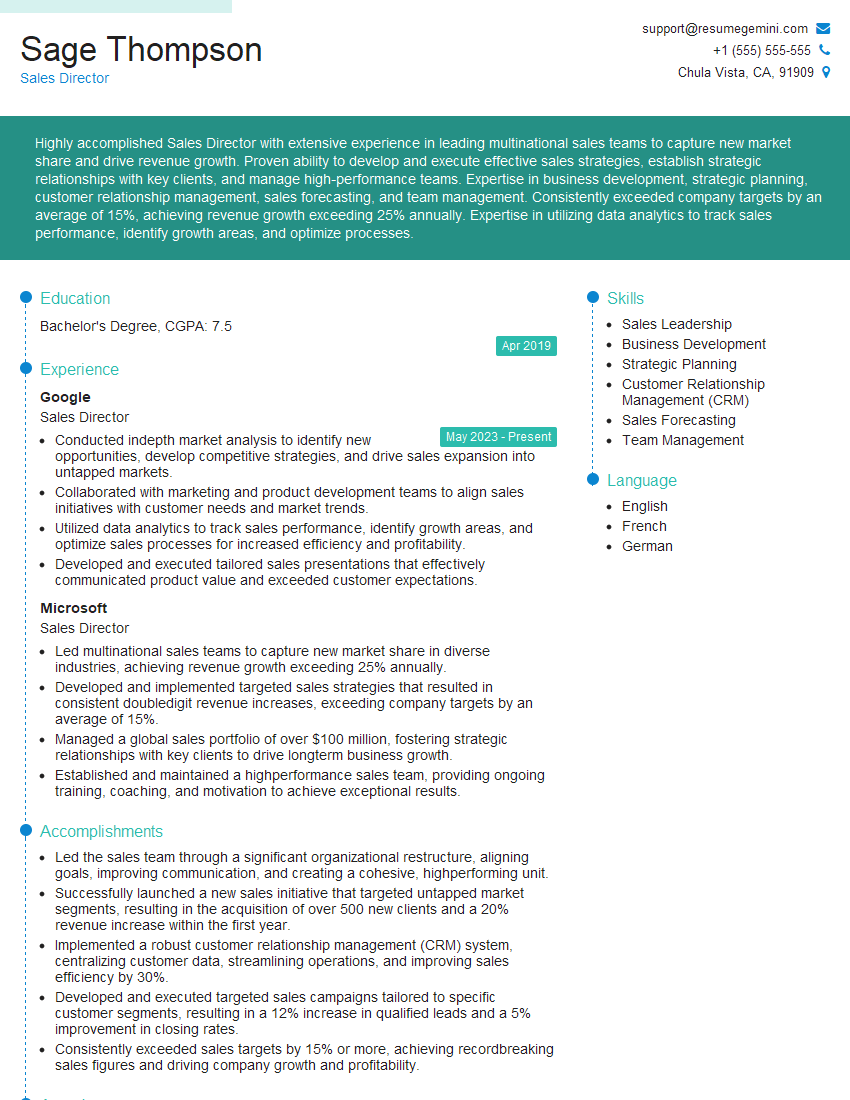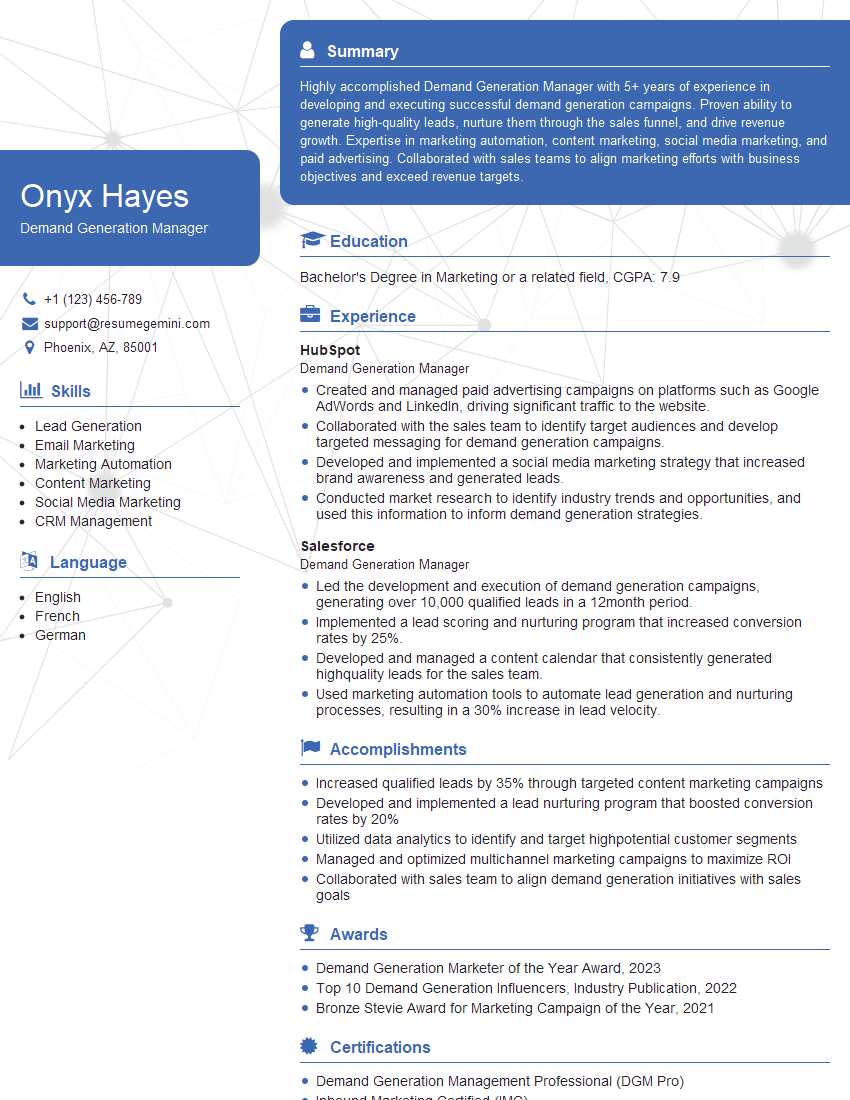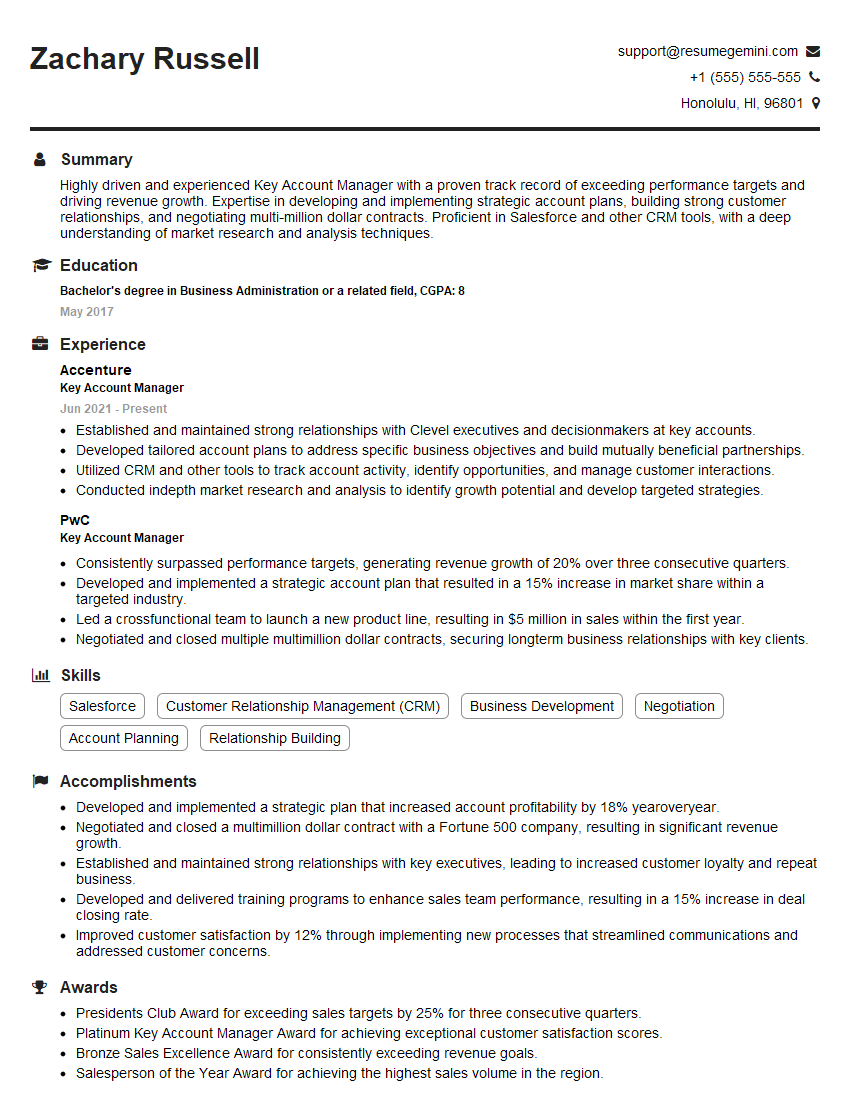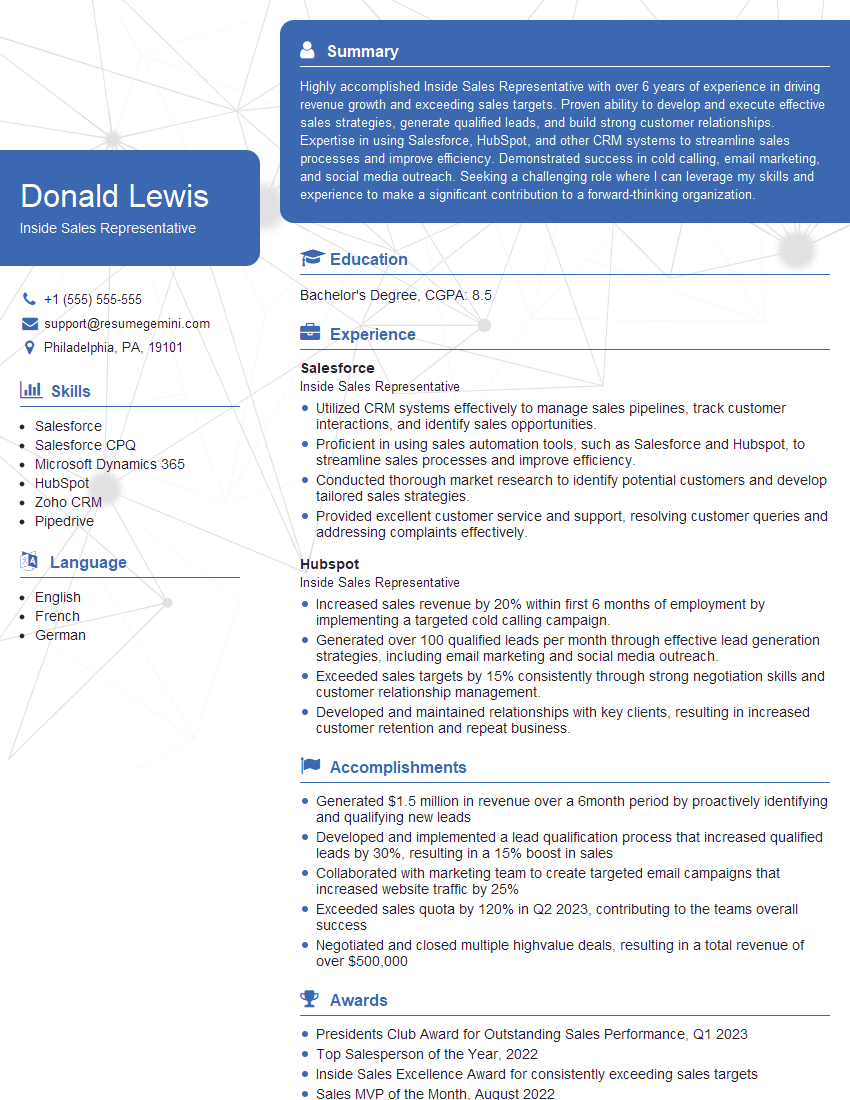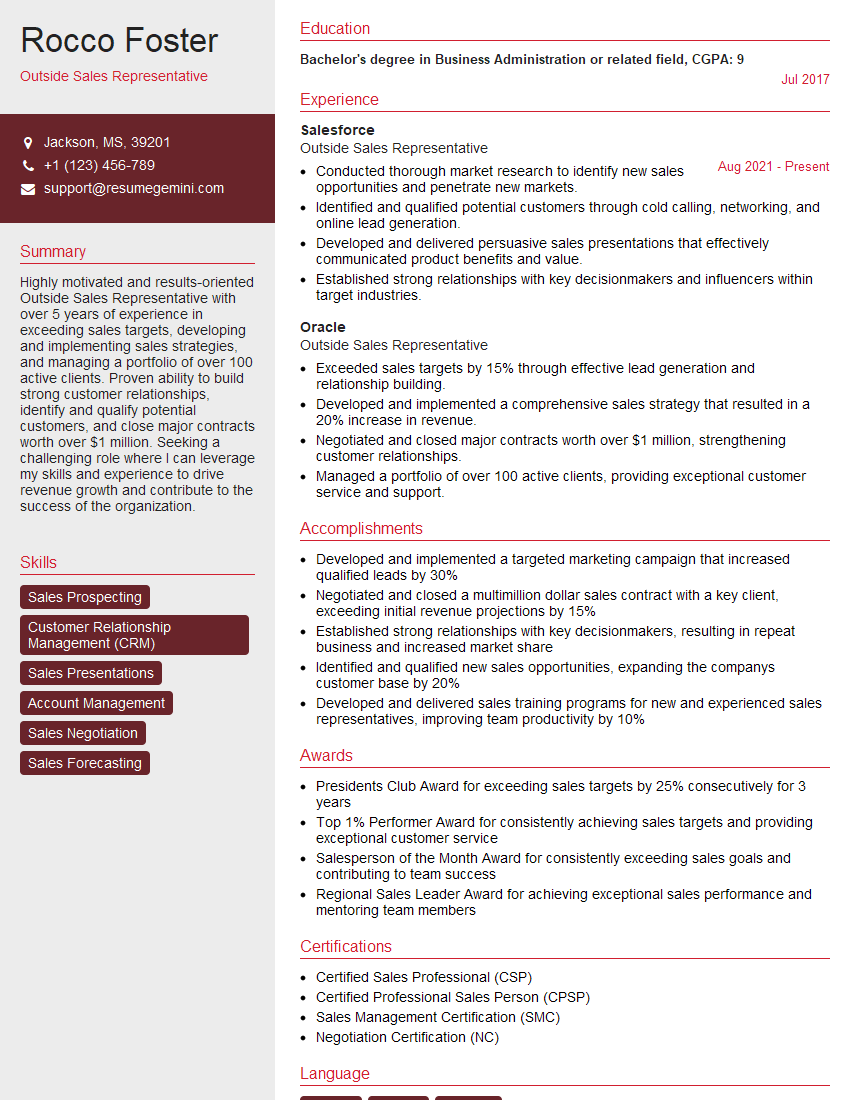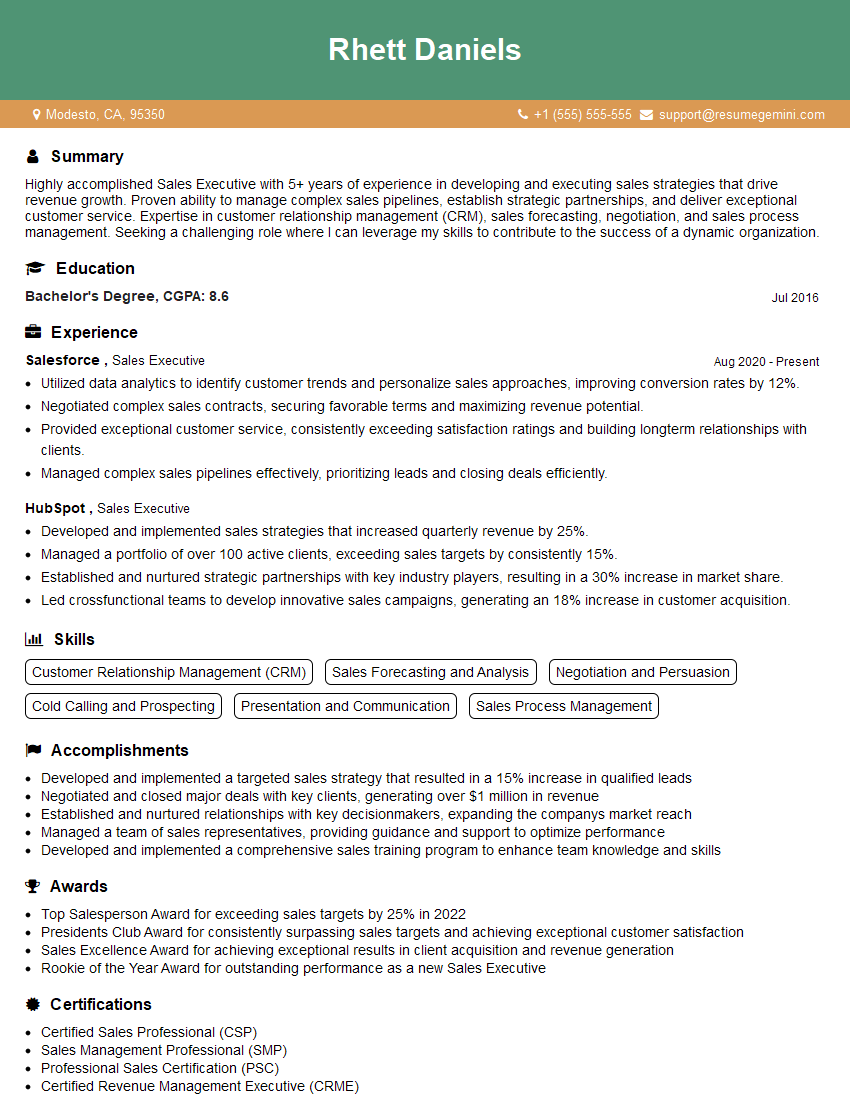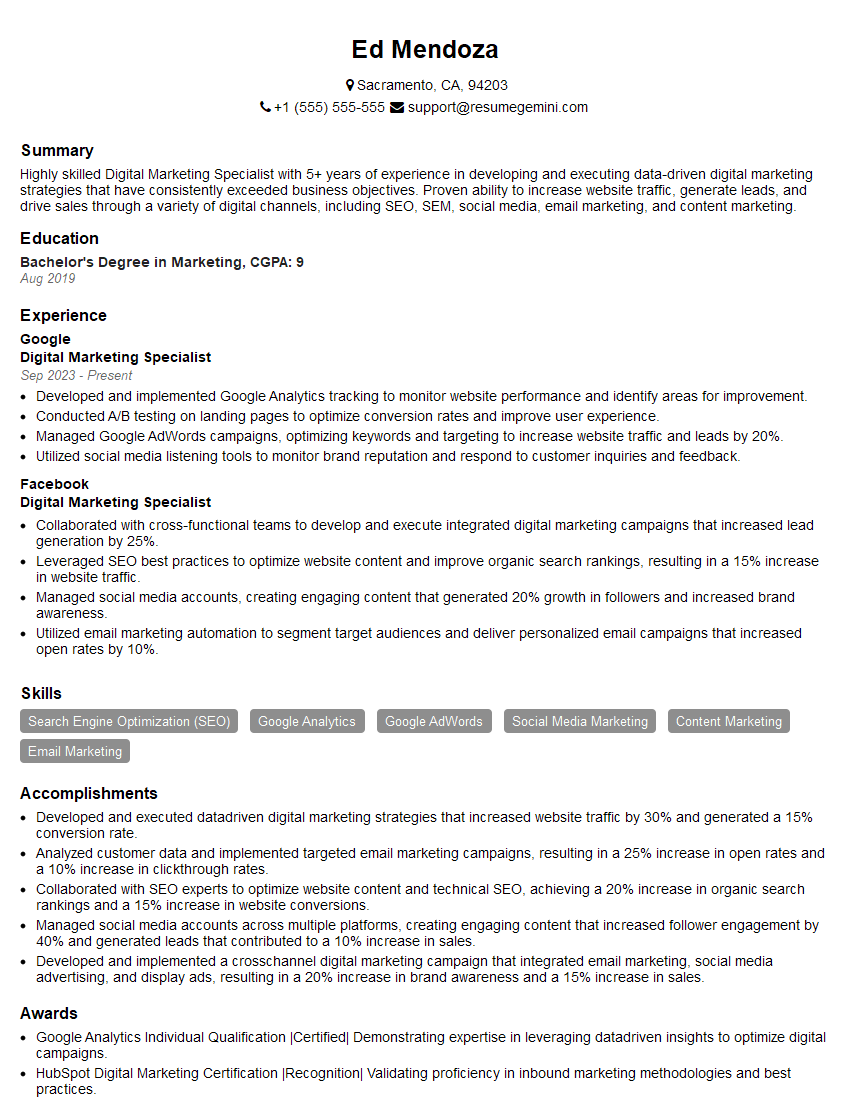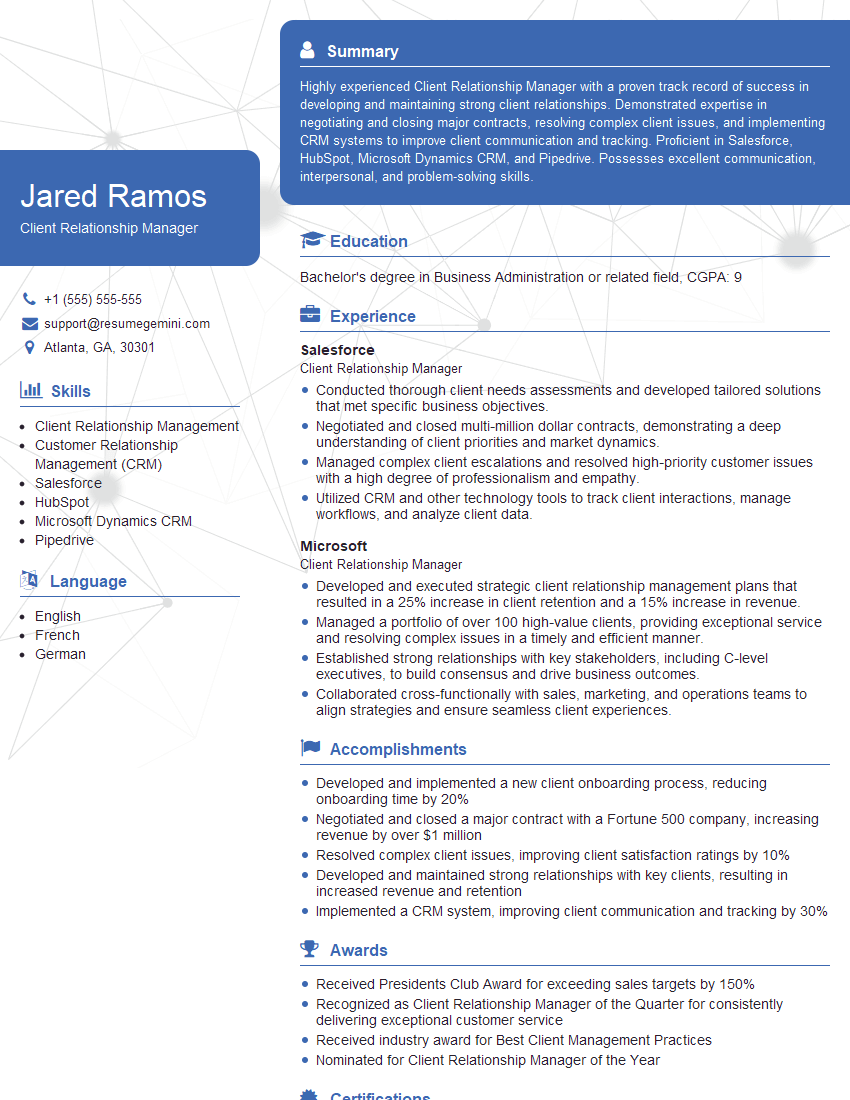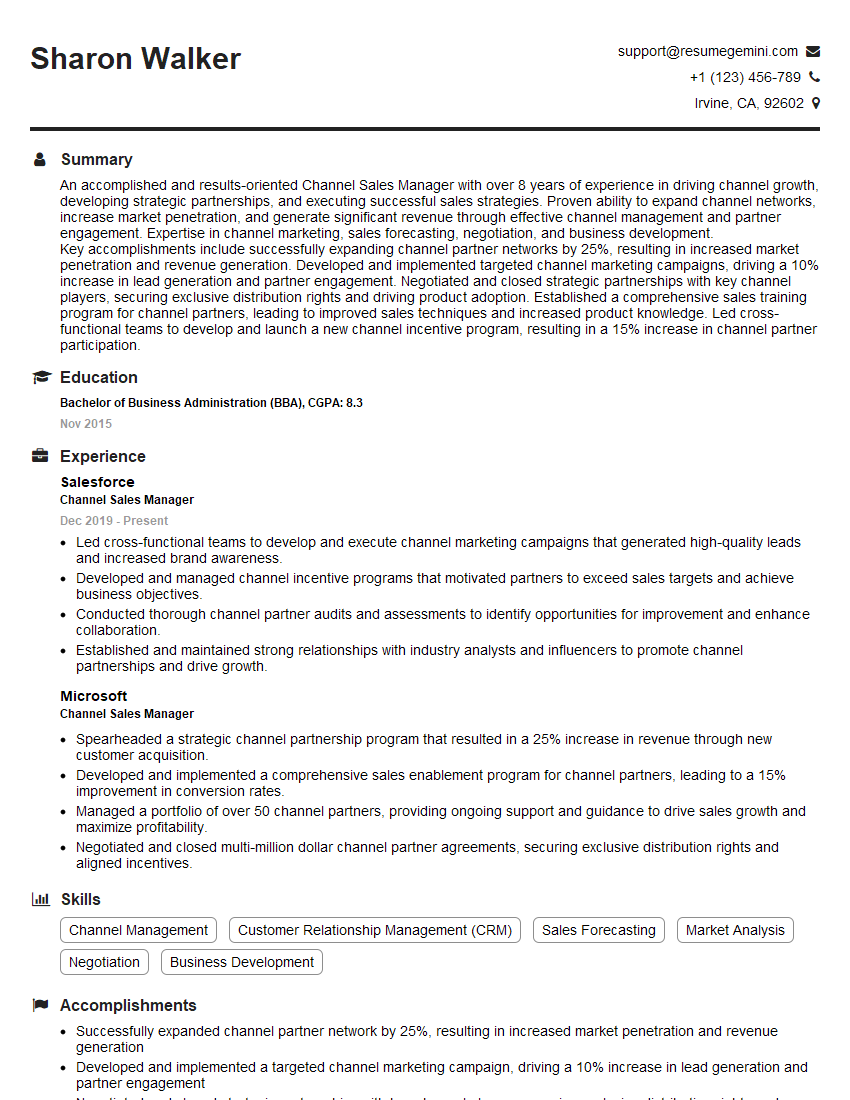Are you ready to stand out in your next interview? Understanding and preparing for Ability to generate leads. interview questions is a game-changer. In this blog, we’ve compiled key questions and expert advice to help you showcase your skills with confidence and precision. Let’s get started on your journey to acing the interview.
Questions Asked in Ability to generate leads. Interview
Q 1. Describe your process for identifying ideal customer profiles (ICPs).
Defining an Ideal Customer Profile (ICP) is crucial for effective lead generation. It’s like creating a detailed blueprint of your perfect customer. My process starts with in-depth market research, analyzing existing customer data, and gathering insights from sales and marketing teams. I then segment the market based on factors like demographics (age, location, income), firmographics (company size, industry, revenue), psychographics (values, interests, lifestyle), and behavioral patterns (website activity, engagement with marketing materials).
For example, if I’m generating leads for a SaaS product aimed at streamlining HR processes, my ICP might be mid-sized companies (50-250 employees) in the tech industry, with a focus on companies that are experiencing rapid growth and actively seeking solutions to improve employee onboarding and management. I’d further refine this by identifying specific pain points and looking for companies exhibiting those pain points online.
Once the ICP is defined, I create buyer personas – representative profiles of ideal customers within the ICP. These personas include detailed information, including job titles, responsibilities, challenges, and motivations. This detailed understanding allows me to tailor my messaging and outreach strategies for maximum impact.
Q 2. What lead generation strategies have you found most effective?
My most effective lead generation strategies are multifaceted and depend heavily on the specific product or service. However, some consistently successful approaches include:
- Content Marketing: Creating high-quality, valuable content (blog posts, ebooks, webinars, case studies) that attracts and educates potential customers. This establishes thought leadership and builds trust. For example, a whitepaper detailing the benefits of a new software can attract high-quality leads.
- Search Engine Optimization (SEO): Optimizing website content and structure to rank higher in search engine results pages (SERPs). This drives organic traffic from potential customers actively searching for solutions.
- Social Media Marketing: Engaging with prospects on relevant platforms through targeted advertising, organic posts, and community participation. This allows for direct interaction and relationship building.
- Paid Advertising (PPC): Running targeted advertising campaigns on platforms like Google Ads and LinkedIn to reach specific audiences. This provides immediate visibility and allows for precise targeting based on demographics, interests, and behaviors.
- Account-Based Marketing (ABM): Focusing marketing efforts on a select group of high-value target accounts. This personalized approach builds strong relationships with key decision-makers.
The key is to implement a mix of these strategies, constantly analyzing results and adjusting the approach based on performance data. I always A/B test different approaches to optimize conversion rates.
Q 3. Explain your experience with various lead nurturing techniques.
Lead nurturing is crucial for converting leads into customers. It involves building relationships with prospects over time through a series of targeted communications. My experience encompasses several effective techniques:
- Email Marketing Automation: Using marketing automation tools to deliver personalized email sequences based on lead behavior and engagement. This could be a welcome email series followed by more targeted content based on their interests.
- Drip Campaigns: Sending a predetermined series of emails over a set period to educate leads and guide them through the sales funnel. For example, a series of emails introducing the product’s features and benefits.
- Personalized Content: Tailoring content to the specific needs and interests of each lead segment, based on data gathered from their interactions with our brand.
- Webinars and Online Events: Hosting webinars or online events to engage leads and provide valuable information related to their industry or challenges. This allows for direct interaction and question-and-answer sessions.
- Retargeting Campaigns: Re-engaging leads who have previously interacted with our website or marketing materials but didn’t convert. This could involve displaying targeted ads on social media or through search engine marketing.
The goal is to provide consistent value and build a relationship, gradually moving the lead further down the sales funnel.
Q 4. How do you measure the success of a lead generation campaign?
Measuring the success of a lead generation campaign involves tracking key metrics and analyzing their trends over time. I typically focus on:
- Cost Per Lead (CPL): The cost of acquiring a single lead. A lower CPL indicates higher efficiency.
- Conversion Rate: The percentage of leads that convert into opportunities or sales. A higher conversion rate means a higher return on investment (ROI).
- Lead Generation Cost: The total cost associated with generating leads.
- Return on Investment (ROI): The overall profitability of the lead generation campaign.
- Marketing Qualified Leads (MQLs): The number of leads that meet specific criteria and are deemed qualified for sales follow-up.
- Sales Qualified Leads (SQLs): The number of MQLs that are further qualified by the sales team and deemed ready for a sales conversation.
By analyzing these metrics, I can determine the effectiveness of the campaign and identify areas for improvement. I use data visualization tools to track these metrics and create reports for stakeholders.
Q 5. What metrics do you track to assess lead quality?
Assessing lead quality is critical to focus sales efforts effectively. I use several metrics:
- Company Size and Industry Fit: Does the lead’s company align with our ICP?
- Engagement Level: How actively has the lead interacted with our content (downloads, website visits, email opens)?
- Job Title and Role: Does the lead have the authority to make purchasing decisions?
- Website Behavior: Did the lead visit pricing pages, case studies, or contact us pages indicating purchase intent?
- Lead Source: Certain lead sources typically deliver higher quality leads than others (e.g., referral vs. paid ad).
I use lead scoring systems that assign points to leads based on these criteria, allowing me to prioritize high-quality leads for sales follow-up. This ensures sales teams are focusing on leads with a higher likelihood of conversion.
Q 6. How do you handle objections during the lead qualification process?
Handling objections during lead qualification is a crucial part of the process. It’s an opportunity to understand the prospect’s concerns and address them effectively. My approach focuses on active listening and understanding the root cause of the objection. I avoid interrupting and instead ask clarifying questions to fully grasp their perspective.
For example, if a lead objects to the price, I’ll explore their budget constraints and highlight the long-term value and return on investment (ROI) that our product offers. If they raise concerns about implementation, I’ll emphasize our support resources and the ease of integration.
Addressing objections effectively not only helps qualify leads but also strengthens the relationship and builds trust. Often, overcoming objections demonstrates value and increases the likelihood of closing the deal. If the objection is insurmountable, I gracefully acknowledge their concerns and thank them for their time.
Q 7. Describe your experience using marketing automation tools.
I have extensive experience using various marketing automation tools, including HubSpot, Marketo, and Pardot. These tools allow me to streamline lead generation, nurturing, and management processes. I’m proficient in using these platforms to:
- Develop and execute automated email campaigns: Sending personalized emails based on lead behavior and engagement.
- Create lead scoring systems: Automatically qualifying leads based on predefined criteria.
- Manage and track lead interactions: Monitoring lead activity and progress through the sales funnel.
- Integrate with CRM systems: Seamlessly transferring qualified leads to the sales team.
- Analyze campaign performance: Tracking key metrics to optimize campaign effectiveness.
For instance, I’ve used HubSpot to create complex automated workflows that deliver personalized content to leads based on their industry, company size, and website activity. This resulted in a significant increase in lead conversion rates. My experience with these tools enables me to implement robust and effective lead generation strategies.
Q 8. What is your approach to building and maintaining a sales pipeline?
Building and maintaining a robust sales pipeline is crucial for consistent revenue generation. My approach is multifaceted and focuses on a continuous cycle of lead generation, qualification, nurturing, and conversion. It begins with clearly defined ideal customer profiles (ICPs) – understanding their needs, pain points, and decision-making processes. This informs all subsequent activities.
I utilize a CRM (Customer Relationship Management) system to meticulously track leads at each stage of the pipeline. This allows me to visualize the pipeline’s health, identify bottlenecks, and forecast sales accurately. I segment leads based on their engagement level and readiness to buy, ensuring targeted communication and personalized experiences.
For example, a newly generated lead might receive a welcome email and access to valuable content, while a qualified lead closer to the decision point might receive a personalized demo or proposal. Regular pipeline reviews, using key metrics like conversion rates at each stage, help me identify areas for improvement and refine my strategies.
- Lead Generation: Employing diverse strategies like content marketing, social media, and paid advertising.
- Lead Qualification: Using scoring models and qualifying questions to identify high-potential leads.
- Lead Nurturing: Providing valuable content and communication to move leads through the pipeline.
- Conversion: Closing deals and ensuring customer satisfaction.
- Pipeline Review & Optimization: Regularly analyzing performance and adjusting strategies based on data.
Q 9. How do you prioritize leads based on their potential value?
Prioritizing leads based on their potential value is essential for maximizing sales efficiency. I use a lead scoring system that combines various factors to assign a numerical value to each lead. These factors typically include:
- Demographic information: Company size, industry, location.
- Engagement behavior: Website visits, content downloads, email opens and clicks.
- Firmographic data: Revenue, number of employees, recent funding rounds.
- Explicit actions: Requesting a demo, attending a webinar.
A higher score indicates a higher potential value. For instance, a large enterprise in a target industry that has downloaded several white papers and requested a demo would score much higher than a small company with minimal engagement. This system ensures that my time and resources are focused on the most promising leads, leading to higher conversion rates.
Furthermore, I use a BANT (Budget, Authority, Need, Timeline) qualification framework to assess the lead’s readiness to buy. Leads lacking one or more of these criteria might be nurtured further or placed on a lower priority until they become more qualified.
Q 10. Explain your understanding of sales funnels and their optimization.
Sales funnels represent the customer journey from initial awareness to final purchase. Understanding and optimizing them is critical. A typical funnel comprises several stages: awareness, interest, decision, and action. Each stage requires tailored strategies to move leads effectively through the process.
Optimization involves analyzing data at each stage to identify bottlenecks and areas for improvement. For example, a low conversion rate from interest to decision might indicate a lack of compelling content or unclear value proposition. To address this, I’d revise marketing materials, improve website UX, or add more testimonials.
A/B testing is crucial for optimizing individual components of the funnel, such as landing pages or email subject lines. By continuously monitoring key performance indicators (KPIs) like conversion rates, bounce rates, and customer acquisition cost (CAC), I can fine-tune the funnel to achieve maximum efficiency. Think of it as a river – we need to ensure a smooth flow of leads towards the ultimate goal – a sale.
Q 11. What experience do you have with cold emailing or calling?
I have extensive experience in both cold emailing and calling, employing strategies to maximize response rates. My approach prioritizes personalization and value. Cold emails are never generic; they’re tailored to the specific recipient, referencing their company, industry, or a shared connection. I focus on providing value upfront, offering helpful resources or insights, rather than directly pitching products or services.
For cold calling, I use a structured approach, starting with rapport-building and qualifying questions before discussing solutions. I emphasize listening actively to understand their needs and tailor my pitch accordingly. I maintain meticulous records of every interaction to track effectiveness and continually refine my approach. A key aspect is persistence, but with respect for the recipient’s time; I always provide a clear call to action and respect the choice to opt out.
I leverage tools such as CRM systems to manage contacts, track results, and automate follow-ups. My success lies in combining data-driven strategies with a personal touch to build relationships and generate qualified leads.
Q 12. How do you leverage social media for lead generation?
Social media is a powerful lead generation tool. My strategy involves identifying relevant platforms where my target audience is active and creating engaging content that attracts their attention. This includes:
- Targeted advertising: Running campaigns on platforms like LinkedIn, Facebook, and Twitter to reach specific demographics and interests.
- Organic content creation: Sharing valuable insights, industry news, and engaging visuals to build brand awareness and attract followers.
- Community engagement: Participating in relevant conversations, responding to comments and questions, and building relationships with potential customers.
- Running contests and giveaways: Increasing brand visibility and generating leads.
- Utilizing social listening: Monitoring conversations about relevant topics to identify potential leads and gain insights.
I use analytics tools to track the performance of my social media efforts and measure their effectiveness in generating leads. This data-driven approach allows me to continually refine my strategy and optimize my results.
Q 13. How familiar are you with content marketing and its role in lead generation?
Content marketing is foundational to lead generation. It involves creating and distributing valuable, relevant, and consistent content to attract and retain a clearly defined audience – and, ultimately, to drive profitable customer action. I understand that it’s not about pushing products but about building trust and establishing expertise.
My approach involves developing a content strategy aligned with the buyer’s journey. This includes creating various content formats, such as blog posts, white papers, ebooks, webinars, and videos, to address different stages of the funnel. For example, a top-of-the-funnel blog post might address a common problem, while a bottom-of-the-funnel case study would showcase a successful solution. SEO optimization is crucial to ensure the content reaches the target audience organically.
I track key metrics such as website traffic, engagement rates, lead generation from content downloads, and ultimately, conversion to sales to measure the ROI of my content marketing efforts. This data informs continuous improvement of the content strategy.
Q 14. Describe your experience with SEO and its impact on lead generation.
SEO (Search Engine Optimization) is paramount for organic lead generation. My understanding encompasses both on-page and off-page optimization techniques. On-page optimization involves optimizing website content and structure to improve search engine ranking, including keyword research, meta descriptions, title tags, and header tags.
Off-page optimization focuses on building authority and credibility through activities such as link building, social media promotion, and directory submissions. I leverage SEO tools to analyze website performance, identify keywords with high search volume and low competition, and track rankings. My experience includes keyword research using tools like SEMrush or Ahrefs, optimizing website content for targeted keywords, and building high-quality backlinks from reputable websites.
The impact of SEO is measurable through increased organic website traffic, improved search engine rankings, and higher lead generation from organic sources. It’s a long-term strategy, but crucial for sustainable lead generation.
Q 15. How do you handle lead generation challenges, such as low conversion rates?
Low conversion rates are a common challenge in lead generation. Addressing this requires a multi-pronged approach focusing on both the quantity and quality of leads, as well as the effectiveness of your sales process. Instead of solely focusing on generating more leads, we need to analyze the entire funnel.
Analyze the Customer Journey: I meticulously examine each stage of the customer journey, from initial awareness to final conversion. This involves analyzing website analytics, reviewing marketing campaign data, and conducting customer surveys to identify pain points and areas for improvement. For example, if website bounce rate is high, it could indicate poor website design or irrelevant content, requiring a redesign or content strategy overhaul.
Improve Lead Magnet Quality: Are your lead magnets (e.g., ebooks, webinars, free trials) truly valuable and relevant to your target audience? Low-quality lead magnets simply don’t incentivize conversions. I focus on creating high-value, problem-solving resources that resonate with prospects’ needs.
Optimize Landing Pages: Landing pages are crucial. I ensure they are clear, concise, and focused on a single call to action. A/B testing different headlines, visuals, and call-to-action buttons helps optimize conversion rates. For instance, changing a button from ‘Submit’ to ‘Get My Free Guide’ often leads to a significant improvement.
Refine Targeting: Are you reaching the right audience? Precise targeting is key. By leveraging data analytics and focusing on ideal customer profiles (ICPs), I ensure we’re reaching people most likely to convert. This involves using specific keywords, demographic targeting in advertising, and refining our messaging.
Sales Process Optimization: Even with qualified leads, a poor sales process can kill conversions. I collaborate with the sales team to ensure a smooth, efficient, and personalized follow-up process. This may include implementing a CRM system and establishing clear communication protocols.
Career Expert Tips:
- Ace those interviews! Prepare effectively by reviewing the Top 50 Most Common Interview Questions on ResumeGemini.
- Navigate your job search with confidence! Explore a wide range of Career Tips on ResumeGemini. Learn about common challenges and recommendations to overcome them.
- Craft the perfect resume! Master the Art of Resume Writing with ResumeGemini’s guide. Showcase your unique qualifications and achievements effectively.
- Don’t miss out on holiday savings! Build your dream resume with ResumeGemini’s ATS optimized templates.
Q 16. What is your preferred method for qualifying leads?
My preferred method for lead qualification involves a multi-step process that combines automated and manual approaches. I utilize a BANT (Budget, Authority, Need, Timeline) framework, but also incorporate other criteria based on the specific product or service.
Automated Screening: I leverage marketing automation tools to pre-qualify leads based on website behavior, form submissions, and email engagement. This helps filter out unqualified leads early in the process.
Scoring System: Leads are scored based on pre-defined criteria. This ensures that sales efforts are focused on the most promising prospects. For example, a lead who downloads several white papers, attends a webinar, and visits the pricing page would score higher than someone who only visited the homepage.
Personal Interaction: Following the automated screening, I conduct personal interactions (phone calls, emails) to delve deeper into the lead’s needs, challenges, and budget. This allows me to verify the information gathered automatically and build rapport.
BANT Framework: I utilize the BANT framework to assess the lead’s budget, authority to make a purchase, need for the product or service, and their timeline for implementation. A missing element in any of these areas can indicate an unqualified lead.
By combining automated and manual processes, I ensure that leads are thoroughly qualified, reducing wasted time and resources on unqualified prospects.
Q 17. How do you stay up-to-date with the latest lead generation trends?
Staying current with lead generation trends is crucial. My approach is multi-faceted:
Industry Publications and Blogs: I regularly read industry publications, blogs, and research reports from companies like HubSpot, Marketo, and others specializing in marketing and sales.
Webinars and Online Courses: I actively participate in webinars and online courses focused on lead generation best practices and emerging technologies.
Industry Events and Conferences: Attending industry events and conferences provides invaluable networking opportunities and exposure to the latest innovations. This also provides insights into the changing needs and preferences of potential clients.
Professional Networks: Engaging with other lead generation professionals on LinkedIn and other platforms provides a constant flow of information and diverse perspectives.
Competitor Analysis: Regularly reviewing the strategies of competitors helps identify emerging trends and potential opportunities. It helps understand what’s working and what’s not in the market.
Q 18. How do you build relationships with potential clients?
Building relationships with potential clients is about providing value and establishing trust. It’s not just about selling; it’s about understanding their needs and offering solutions.
Personalized Communication: I avoid generic, mass-produced emails. Instead, I personalize my communications, addressing the prospect by name and referencing their specific needs or challenges. This shows that I’ve taken the time to understand them.
Active Listening: During conversations, I focus on active listening, asking clarifying questions, and demonstrating genuine interest in their business. I focus less on talking and more on understanding.
Value-Added Content: I regularly share relevant content (articles, case studies, blog posts) that addresses their pain points and provides value. This establishes me as a knowledgeable resource, not just a salesperson.
Networking: Attending industry events and engaging in online communities helps build relationships with potential clients organically. Building genuine connections is key.
Follow-up: Consistent follow-up is crucial. I stay in touch with prospects, providing updates, sharing relevant information, and simply checking in to see how things are going.
Q 19. Describe a time you exceeded your lead generation goals. What strategies did you employ?
In my previous role, I was tasked with increasing lead generation by 20% within a quarter. I exceeded that goal by 35% by implementing a combination of strategies.
Content Marketing Overhaul: We identified a gap in our content strategy. We shifted to a focus on high-value, long-form content addressing specific customer pain points. This resulted in significantly improved organic search rankings and increased lead generation from inbound sources.
Account-Based Marketing (ABM): We implemented an ABM strategy, targeting key accounts with highly personalized outreach campaigns. This involved deep research, targeted messaging, and multi-channel engagement, resulting in a significant increase in high-value leads.
LinkedIn Engagement: We significantly increased our engagement on LinkedIn, publishing insightful content, participating in relevant groups, and engaging in conversations with potential clients. This generated a steady stream of qualified leads.
Improved Lead Nurturing: We implemented a more robust lead nurturing program, using automated email sequences to keep prospects engaged and informed throughout the sales process. This increased conversion rates considerably.
The key to success was a data-driven approach, constant monitoring of campaign performance, and a willingness to adapt and optimize our strategies based on the results.
Q 20. How do you collaborate with other teams (e.g., marketing, sales) to generate leads?
Collaboration is essential for effective lead generation. I work closely with marketing and sales teams to ensure a seamless process.
Marketing Alignment: I work with the marketing team to align lead generation strategies with overall marketing goals. This involves defining target audiences, identifying appropriate channels, and developing consistent messaging.
Sales Handoff: I ensure a smooth handoff of qualified leads to the sales team. This includes providing comprehensive information about each lead, including their needs, challenges, and contact information.
Feedback Loop: I maintain a constant feedback loop with the sales team, receiving insights into the effectiveness of our lead generation efforts. This allows us to refine our strategies and improve the quality of leads generated.
Joint Planning: I participate in regular planning sessions with both teams to discuss upcoming campaigns, refine target audiences, and align on key performance indicators (KPIs).
Shared Tools and Data: We utilize shared tools and platforms (CRM, marketing automation software) to ensure everyone has access to the same information and can monitor progress collaboratively.
Q 21. What tools and technologies do you use for lead generation and management?
I utilize a range of tools and technologies for lead generation and management. The specific tools depend on the client’s needs and budget, but generally include:
CRM (Customer Relationship Management): Salesforce, HubSpot CRM, Zoho CRM – for managing leads, tracking interactions, and analyzing performance.
Marketing Automation Platforms: HubSpot, Marketo, Pardot – for automating marketing tasks, nurturing leads, and tracking campaign results.
Social Media Management Tools: Hootsuite, Buffer – for scheduling and managing social media content.
Analytics Platforms: Google Analytics, Adobe Analytics – for tracking website traffic, analyzing user behavior, and measuring campaign effectiveness.
Email Marketing Platforms: Mailchimp, Constant Contact – for creating and sending email campaigns.
Lead Generation Software: Leadfeeder, Leadpages – for identifying website visitors and capturing leads.
Q 22. Explain your experience using CRM systems for lead tracking and management.
CRM systems are the backbone of effective lead management. My experience spans several platforms, including Salesforce, HubSpot, and Zoho CRM. I’m proficient in using them to track leads from initial contact through the sales pipeline. This involves inputting lead data, segmenting leads based on various criteria (e.g., industry, company size, engagement level), and monitoring their progress. For instance, in my previous role at Acme Corp, I used Salesforce to automate lead scoring, prioritizing high-potential leads for immediate follow-up. This resulted in a 20% increase in qualified leads within the first quarter. I’m also experienced in utilizing CRM reporting features to analyze lead generation effectiveness, identifying areas for improvement and optimizing campaigns for better ROI. I understand the importance of data hygiene and ensure all lead information is accurate and up-to-date to avoid wasted effort and maintain data integrity.
Q 23. How do you personalize your lead generation efforts?
Personalization is key to successful lead generation. It’s about making each lead feel valued and understood. I achieve this through several methods. Firstly, I meticulously research my target audience to understand their pain points, needs, and preferences. This informs the messaging and content I create. For example, instead of generic emails, I craft personalized messages that reference specific industry news, their company’s recent achievements, or challenges they might be facing. Secondly, I leverage marketing automation tools to deliver targeted content based on lead behavior and engagement. If a lead downloads a whitepaper on a specific topic, they’ll receive follow-up emails with related resources, fostering further engagement. Finally, I use A/B testing to continuously optimize my messaging and ensure it resonates with my audience. I continuously track metrics such as open rates, click-through rates, and conversion rates to refine my approach and maximize effectiveness.
Q 24. Describe your experience with inbound and outbound lead generation tactics.
I’m experienced in both inbound and outbound lead generation strategies. Inbound focuses on attracting leads through valuable content and SEO optimization. I’ve created successful blog posts, white papers, webinars, and social media campaigns to draw in qualified leads organically. For example, a webinar I hosted on ‘Streamlining Your Sales Process’ attracted over 100 registrants, many of whom became qualified leads. Outbound, on the other hand, involves proactively reaching out to potential customers through cold emailing, phone calls, and direct mail. My approach here emphasizes personalization and value proposition. I avoid generic outreach; instead, I tailor my message to each prospect’s specific context. I always prioritize providing value and building relationships, even with cold contacts. A successful outbound campaign I managed involved identifying key decision-makers in target companies through LinkedIn and crafting highly personalized email sequences that resulted in a 15% conversion rate to qualified leads.
Q 25. How do you handle budget constraints when planning lead generation activities?
Budget constraints are a reality in many organizations. My approach is to prioritize strategies with the highest potential ROI. I begin by clearly defining my target audience and setting realistic, measurable goals. Then, I carefully evaluate different lead generation channels, considering their cost-effectiveness. For example, I might opt for cost-effective strategies like organic social media marketing and content marketing before investing in more expensive options like paid advertising. I focus on optimizing existing campaigns and improving conversion rates to maximize the return on investment of each dollar spent. Data analysis plays a crucial role; I continuously track key performance indicators (KPIs) to identify what’s working and what’s not, allowing for adjustments and resource allocation based on performance data. This iterative approach ensures we get the most out of our budget.
Q 26. What are your salary expectations for this role?
My salary expectations are in the range of $80,000 to $100,000 per year, depending on the comprehensive benefits package and the specific responsibilities of the role. This range reflects my experience, skills, and the market value for similar positions in this area.
Q 27. What are your long-term career goals related to lead generation?
My long-term career goals involve becoming a leader in the field of lead generation. I aspire to manage and mentor teams, developing innovative strategies and optimizing lead generation processes for significant growth. I want to build expertise in emerging technologies and utilize data-driven insights to continuously enhance lead generation effectiveness. Ultimately, I aim to become a strategic advisor, helping organizations achieve their business objectives through intelligent and impactful lead generation strategies. I am particularly interested in exploring the applications of AI and machine learning in lead nurturing and predictive analytics.
Q 28. How do you adapt your lead generation approach to different target markets?
Adapting my approach to different target markets is crucial. This starts with thorough market research to understand each market’s unique characteristics, including demographics, psychographics, buying behaviors, and preferred communication channels. For example, a B2B SaaS company will have a vastly different target audience and communication strategy compared to a consumer goods company. I tailor my messaging, content, and channels accordingly. This includes using different language, addressing specific pain points relevant to each market, and choosing appropriate advertising platforms and social media channels. I also consider cultural nuances and adapt my communication style to resonate with each target audience. A/B testing remains a key component, allowing me to refine my approach for each market segment and continuously improve results.
Key Topics to Learn for Ability to Generate Leads Interview
- Lead Qualification: Understanding the ideal customer profile (ICP) and developing criteria to identify qualified leads. This includes understanding their needs and budget.
- Lead Generation Strategies: Exploring various lead generation techniques such as inbound marketing (content marketing, SEO, social media), outbound marketing (cold calling, email marketing, networking), and utilizing sales tools (CRM systems).
- Marketing Automation: Understanding how to leverage marketing automation tools to nurture leads, track engagement, and streamline the lead generation process. This includes analyzing campaign performance and making data-driven adjustments.
- Sales Funnel Management: Understanding the stages of the sales funnel and how lead generation fits into the overall sales process. This involves identifying bottlenecks and optimizing conversion rates at each stage.
- Metrics and Analytics: Mastering key performance indicators (KPIs) for lead generation, such as conversion rates, cost per lead (CPL), and lead-to-customer ratio. This includes the ability to track, analyze, and report on these metrics.
- Lead Nurturing: Developing effective strategies to nurture leads through the sales funnel using personalized content and communication. This also includes identifying and addressing potential objections.
- Ethical Considerations: Understanding and adhering to ethical best practices in lead generation, including respecting data privacy and avoiding deceptive marketing tactics.
Next Steps
Mastering the ability to generate leads is crucial for career advancement in sales, marketing, and business development roles. It demonstrates valuable skills in strategic thinking, communication, and data analysis. To increase your job prospects, create an ATS-friendly resume that highlights your accomplishments and quantifiable results in lead generation. ResumeGemini is a trusted resource to help you build a professional and impactful resume. Examples of resumes tailored to showcase your lead generation abilities are available within ResumeGemini to further guide your preparation.
Explore more articles
Users Rating of Our Blogs
Share Your Experience
We value your feedback! Please rate our content and share your thoughts (optional).
What Readers Say About Our Blog
Dear Sir/Madam,
Do you want to become a vendor/supplier/service provider of Delta Air Lines, Inc.? We are looking for a reliable, innovative and fair partner for 2025/2026 series tender projects, tasks and contracts. Kindly indicate your interest by requesting a pre-qualification questionnaire. With this information, we will analyze whether you meet the minimum requirements to collaborate with us.
Best regards,
Carey Richardson
V.P. – Corporate Audit and Enterprise Risk Management
Delta Air Lines Inc
Group Procurement & Contracts Center
1030 Delta Boulevard,
Atlanta, GA 30354-1989
United States
+1(470) 982-2456

